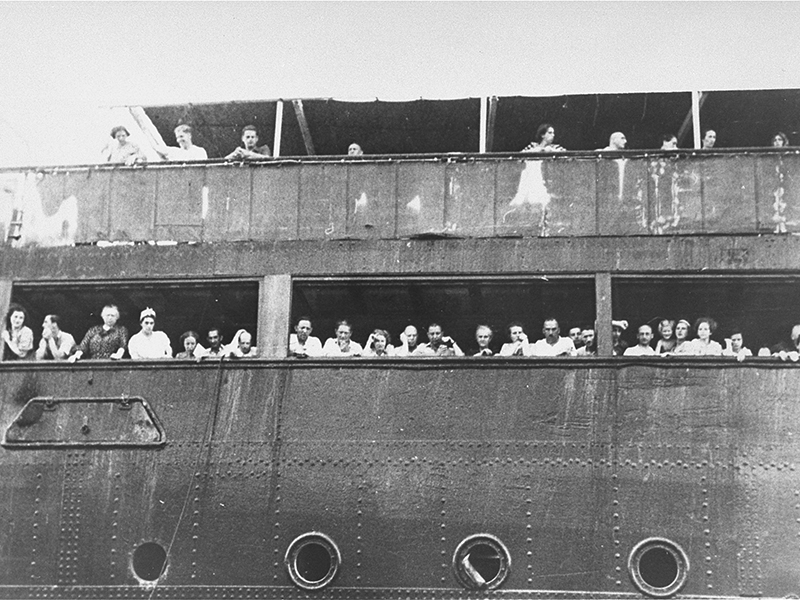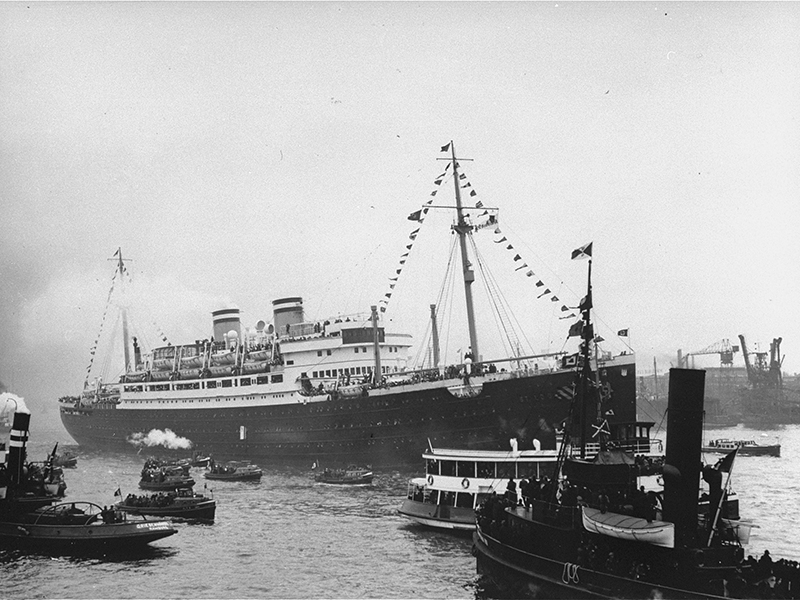Canadian Jewry in the era of ‘none is too many’

Jews on the St. Louis were forced back to Europe.
[In honour of Canada’s 150th birthday, The CJN presents essays on 10 significant moments in Canadian Jewish history.]
On May 15, 1939, 907 desperate German Jews set sail from Hamburg on the luxury liner, the St. Louis. They had been stripped of all of their possessions by the Nazis, hounded out of their homes and businesses, and now their country. Their most prized possession was the Cuban entry visa each carried on board. Yet they considered themselves lucky; they were leaving a country in which living as a Jew had become impossible.
When they reached Havana their luck ran out. The Cuban government refused them admission. For the next week the frantic passengers vainly sought a port that would allow them entry. Every country in South America refused. The United States’ response was even more cruel: it sent a gunboat to shadow the St. Louis in case it got close enough to allow passengers to swim ashore.
Only Canada remained.
The line drawn, the passengers’ last flickering hope for rescue extinguished, the Jews on the St. Louis were forced back to Europe where many were killed in the death camps of the Third Reich.
Canada arguably had the worst record of any western nation in accepting Jews attempting to escape the Nazis. When it came to Jewish refugees, “none is too many” was the official policy. As a prominent Jewish leader wrote at the time, “the world is divided into two parts – those places where Jews cannot live, and those they cannot enter.” Canada fell into the latter category. Indeed, to the condemned Jews in Auschwitz, Canada had a unique meaning. It was the name given to the camp barracks where the gold, valuables and clothing of the inmates were stored. It represented life, luxury and salvation. It was also isolated and unreachable, as was Canada in the 1930s and ’40s.
Why Canada had the worst record of any western nation in trying to save the condemned Jews of Europe was the subject of None Is Too Many, a book written by Harold Troper and me some 35 years ago, and recently republished by the University of Toronto Press. It is a story that shocked many Canadians who believed the national myth that theirs is a country of immigrants that has a long uninterrupted history of welcoming refugees and dissidents, a country that has always been in the forefront of accepting the world’s dispossessed and oppressed, and where racism and bigotry are foreign creations that play little role in Canadian history or the Canadian psyche.
Ours is the story of the old, scarcely recognizable Canada of the first half of the 20th century, a benighted, closed, xenophobic society in which minorities were barred from almost every sector of Canadian life. It was then a Canada whose immigration policies were racist and exclusionary, a country blanketed by an oppressive anti-Semitism, in which Jews were the pariahs of Canadian society, demeaned, despised, discriminated against. Worst of all, anti-Jewish bigotry had permeated the upper levels of the Canadian government whose decisions closed Canada’s doors to the desperate Jews of Europe.

The St. Louis was turned away from Canada and the U.S.
For Canadian Jews in those years, quotas and restrictions were a way of life. According to a study commissioned by the Canadian Jewish Congress – but never released because of its explosive nature – few employment possibilities were open to Jews. Few school teachers and no principals were Jewish. Banks, insurance companies, and large industrial and commercial firms did not hire Jews. Department stores excluded Jews from sales positions. Jewish doctors could not get hospital appointments. Indeed, interns in all Quebec Catholic hospitals went out on strike to protest the hiring of a Jewish intern at the Notre Dame hospital. Not only did universities and professional schools devise quotas against Jewish students, but they did not hire Jewish faculty. For most of this period there was not one full-time Jewish professor anywhere in the country. The report added that it was almost impossible for Jewish nurses, architects and engineers to find jobs in their fields. And some only succeeded by hiding their identities, at least until they were unmasked.
If Jews experienced difficulty finding jobs and getting an education, finding a place to live or vacation was even harder. Increasingly restrictive covenants were placed on various properties prohibiting their sale or rental to Jews, and at beaches and resorts throughout the country signs were springing up banning Jews. So called ‘swastika clubs’ of young hoodlums were formed to intimidate Jews and keep them away from ‘restricted’ beaches. Anti-Jewish demonstrations broke out in many Canadian cities, the worst of which was the notorious Christie Pits riot in Toronto in August of 1933 when hundreds of thugs terrorized a Jewish baseball team in a battle that lasted for six hours, in which scores were injured as Jewish reinforcements arrived and the combatants poured into neighbouring streets.
What is most astonishing about this anti-Semitism is how few and how powerless Canadian Jews were at this time. At about 170,000, they made up one per cent of the population and had no economic or political clout. And they had few allies – the churches, the labour movement, political parties, the media, were largely silent in the face of this frightening, oppressive anti-Jewish sentiment.
Today’s Canada is far different and infinitely better – generous, open, decent, humane. Multiculturalism is now an integral part of Canadian policy, and diversity is encouraged. At a time when intolerance seems to be the global growth industry of the new century successive Canadian governments seemed to have learned the lessons of this shameful episode of Canadian history. The None Is Too Many period has become an ethical yardstick against which contemporaneous government policies are gauged. Canada’s mean-spirited behaviour during the Holocaust is often cited in today’s debates over refugee and immigration policy and has resulted in these policies being more humane and welcoming. And that ultimately is the lesson of this era, one that Canada has taken to heart, that never again for anyone should none be too many.
Irving Abella is the Shiff Chair of Canadian Jewish History at York University and the co-author of None Is Too Many.
[original here]
Category: Canada



